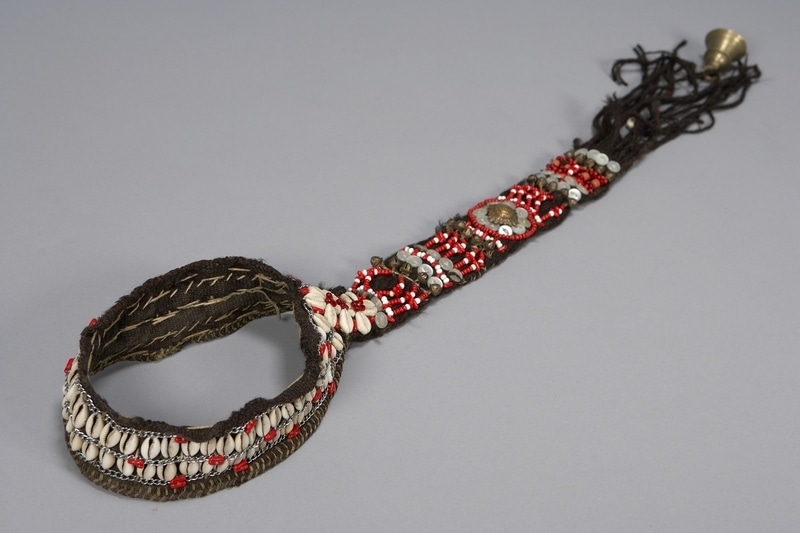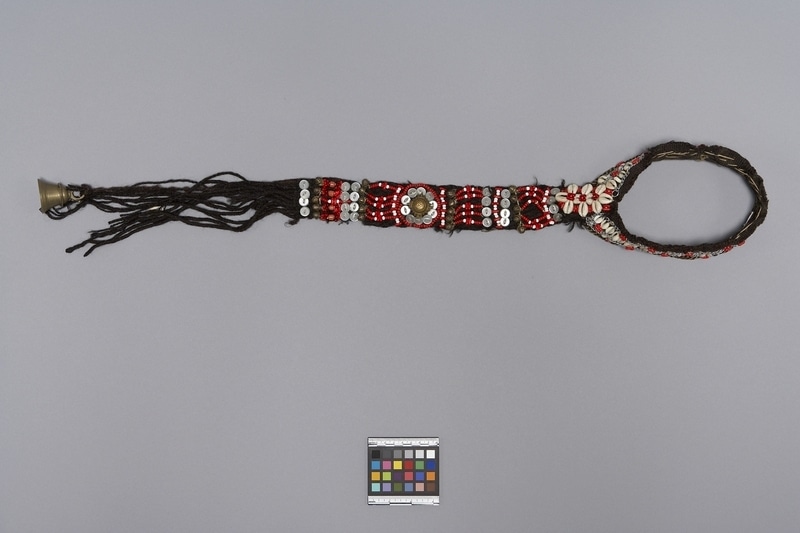Headdress Item Number: B794 from the MOA: University of British Columbia



Description
A black headdress with a circular band and a long tail, decorated with shells, buttons, beads, and bells. The circular band has two rows of shells bordered with a thin metal chain and red oblong beads in pairs. Along the tail there are rows of clear buttons and small brass bells. There are also rows of five vertical strands of round red beads with two round white beads and two red oblong beads in the centre. About halfway down the tail there is a large brass ornament surrounded by a circle of clear buttons and round red beads. At the end of the tail there is a long black fringe with a large brass bell tied to the end of two fringe strands.
History Of Use
Worn daily, both in public and in private. At festive occasions, the shusut is worn underneath a larger, more elaborate headdress, called a kupas (see 1498/2). Girls receive their first headdress at about age 7 at an initiation rite. A woman must not go bareheaded; if the headdress is taken off for cleaning, the woman must wear a shawl over her head. The headdress is removed for funerals to mark respect for the dead.
Narrative
The Kalash are geographically isolated in several valleys in northern Pakistan, close to the Afghan border. Although they are surrounded by Islamic peoples, their religion is polytheistic, with a Vedic pantheon. Linguistically, however, they are related to Afghani and the languages of Swat.
The long “tail” of the shushut is thought to have evolved from long, loose fringes. The dark brown wool textile may have been dyed with walnuts. The shells, bark and nuts themselves are used to obtain a dark colour.
Item History
- Made by Janigoule (Maker) in Broun, Northwest Frontier, Pakistan before 1973
- Collected during 1973
- Owned by Gillian Darling Kovanic before April 1, 1974
- Received from Barrett Montford Endowment Fund (Funding source) and Gillian Darling Kovanic (Seller) on April 1, 1974
What
- Name
- Headdress
- Identification Number
- B794
- Type of Item
- headdress
- Material
- wool fibre, metal, glass, brass metal, plastic and cowrie shell
- Manufacturing Technique
- sewn and woven
- Overall
- height 83.5 cm, width 14.0 cm, depth 14.0 cm
Who
- Culture
- Kalash
- Creator
- Janigoule (Maker)
- Previous Owner
- Gillian Darling Kovanic
- Received from
- Barrett Montford Endowment Fund (Funding source) and Gillian Darling Kovanic (Seller)
Where
- Holding Institution
- MOA: University of British Columbia
- Made in
- Broun, Northwest Frontier, Pakistan
When
- Creation Date
- before 1973
- Collection Date
- during 1973
- Ownership Date
- before April 1, 1974
- Acquisition Date
- on April 1, 1974
Other
- Item Classes
- textiles
- Condition
- good
- Accession Number
- 0254/0004